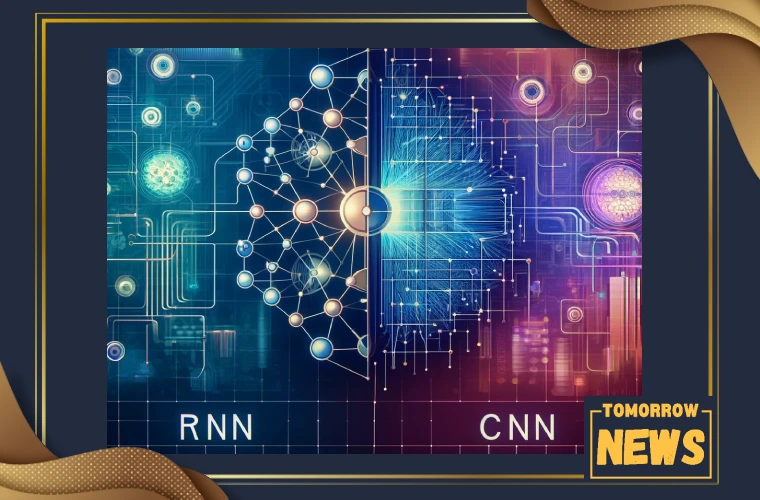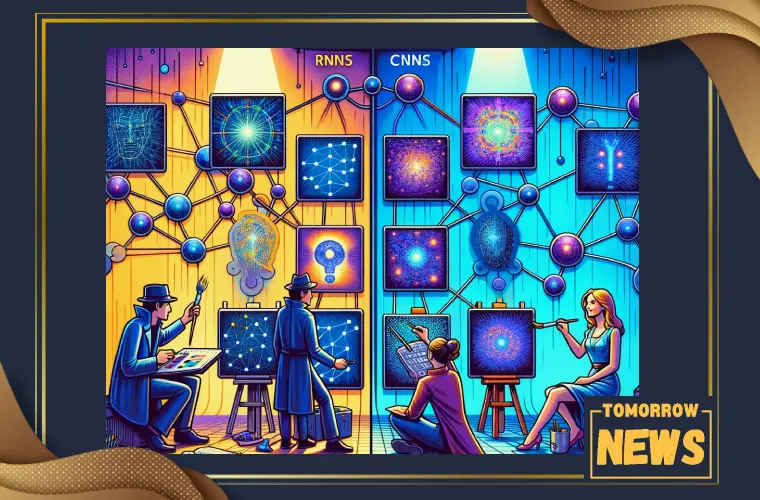Deep learning, has two main players: RNNs and CNNs. These are like different tools in a toolbox, each suited for specific tasks. So, let’s break down (RNN vs CNN) the difference between Recurrent Neural Networks (RNNs) and Convolutional Neural Networks (CNNs) in an approachable way.

RNN vs CNN: Key Differences in Deep Learning Explained
Deep learning has become a buzzword, capturing the interest of many as a powerful tool for solving complex problems. Yet, not everyone knows how these systems came to be. Understanding the roots of deep learning helps in choosing the right architecture for specific tasks.
Neural networks are the brain behind deep learning’s incredible capabilities.
But they aren’t as complicated as you might think, neural networks are the brain behind deep learning’s incredible capabilities. These frameworks use layers of neurons, much like brain synapses, to process and transform data. Starting from the input layer, data moves through hidden layers before reaching the output layer, which makes the final decision. Understanding this flow can demystify how neural networks tackle specific problems.
RNNs (Recurrent Neural Networks) revolutionize deep learning by introducing the concept of memory.
RNNs are like detectives with a sharp memory. They’re great at analyzing sequences of data, like a detective piecing together clues in a mystery. For example, in speech recognition or predicting stock prices, RNNs excel because they can remember past information and use it to make predictions about what comes next.

RNNs revolutionize deep learning by introducing the concept of memory, but they aren’t just about remembering the past. Imagine you’re reading a book and need to remember the plot from previous chapters to understand the current one. RNNs work similarly by feeding outputs from certain layers back into previous layers. This feedback loop is crucial for tasks involving sequential data, like predicting stock prices or translating languages. A subtype of RNN, the Long Short-Term Memory Network (LSTM), excels at learning long-term dependencies, making it ideal for applications like autocomplete or speech recognition.
Types of RNNs
RNNs come in various forms:
- One-to-One (Vanilla RNN): Processes single input to single output (e.g., image classification).
- One-to-Many: Single input to multiple outputs (e.g., image captioning).
- Many-to-One: Multiple inputs to single output (e.g., sentiment analysis).
- Many-to-Many: Multiple inputs to multiple outputs (e.g., language translation).
Applications of RNN
RNNs shine in many applications:
- Image Classification: Recognizing if an image is a daytime or nighttime picture.
- Image Captioning: Generating descriptive captions for images.
- Time Series Prediction: Forecasting future values based on historical data.
- Language Translation: Translating text or speech from one language to another.
- Natural Language Processing: Analyzing social media posts for sentiment.
- Speech and Handwriting Recognition: Converting spoken words or handwritten text into digital formats.
CNNs transform image processing with their grid-like data approach.
On the other hand, CNNs are like artists with a keen eye for detail. They’re perfect for tasks involving images or patterns. Imagine a painter capturing the essence of a scene – that’s what CNNs do with images, recognizing shapes, objects, and features within them. They’re often used in tasks like image classification, where they identify what’s in a picture.

And they can detect intricate patterns like edges and textures! CNNs transform image processing with their grid-like data approach, but they don’t need full connections to work their magic. These networks act like sophisticated filters, detecting patterns such as edges and textures in images. Unlike traditional neural networks, CNN layers are not fully connected; they use convolutional layers to extract features and pooling layers to reduce data dimensionality. This speeds up the training process and helps reduce overfitting, making CNNs exceptionally efficient for image-related tasks.
CNN Architecture
A typical CNN has:
- Convolutional Layers: These layers apply filters to the input to create feature maps.
- Pooling Layers: Reduce the size of the feature maps, retaining essential information.
- Fully Connected Layers: Every neuron is connected to every neuron in the next layer, leading to the final classification.
Usage in Computer Vision
CNNs are the go-to for computer vision tasks such as:
- Medical Image Analysis: Detecting anomalies in medical scans.
- Image Recognition: Identifying objects or faces in images.
- Video Analysis: Understanding actions and events in videos.
Other Applications
Beyond vision, CNNs have proven effective in:
- Natural Language Processing: Tasks like semantic parsing and sentence modeling.
- Drug Discovery: Predicting interactions between molecules to find new drugs.
- Game Playing: Training AI to play games like Checkers and Go at professional levels.
RNN vs CNN – They are Not Mutually Exclusive!
Interestingly, RNNs and CNNs can be combined for even greater effectiveness. A hybrid approach leverages the strengths of both architectures. For instance, DanQ is a hybrid model that uses CNNs to detect patterns in DNA sequences and RNNs to capture long-term dependencies, enhancing the prediction accuracy.
Where They Shine | RNN vs CNN
RNNs are best suited for tasks where data has a sequential or time-dependent structure, like language translation or analyzing time series data. They’re like detectives solving cases where the order of events matters.
CNNs, on the other hand, are perfect for tasks involving spatial relationships, like image recognition or object detection in photos. They’re like artists painting a picture, focusing on the details and shapes within an image.

Conclusion | RNN vs CNN
Choosing between RNN and CNN depends on the task at hand. RNNs excel in handling sequential data and context-sensitive tasks, while CNNs are unparalleled in image and video analysis. In some cases, a hybrid model combining both can offer the best of both worlds. By understanding these differences, we can make informed decisions on which architecture to use for specific deep learning challenges. Click here to view at LinkedIn.
AI-driven solutions is transforming the restaurant and retail experience

Still, using outdated systems? Discover the 3-in-1 AI Self-Ordering Kiosk.
The integration of Recommendation Systems, Large Language Models (LLMs), and Speech Recognition in AI-driven solutions is transforming the restaurant and retail experience. This technology offers a seamless and intuitive ordering process, enhancing both customer satisfaction and operational efficiency.